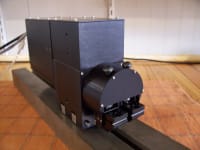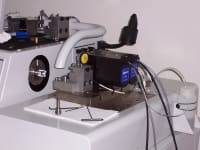The JNX-1000 is an air bearing fast axis capable of 20g acceleration and 1000 micrometers of travel at a frequency of 100Hz and is specifically designed to cut non-rotationally symmetric surfaces. Very fast ultra-precision eddy current sensors are used for position feedback. The Fast Tool Servo (FTS) incorporates an air bearing reaction mass that travels in opposition to the tool carriage insuring that the FTS will not excite any modes of vibration on the machine that it is mounted to. The axis provides two tool mounting platforms with integral coarse and fine adjust making the initial setting of the tool height predictable and fast. The tool platforms can hold one 6.35 mm square tool shank per platform and are designed to hold diamond tool inserts for coarse cutting and then final cutting of such surfaces as contact lenses, intraocular lenses and complex surfaces of rotation. The FTS dimensions are 210mm long, 63mm wide and 111mm high and can be mounted to a T-Slot on a tooling plate. An electronics module consisting of a power distribution module (PDM) and an electronics module (EM) are provided. The PDM utilizes linear power supplies to keep the system noise to an absolute minimum. The electronics houses the position sensor amplifier and the JONIX-designed servo control boards. The electronics module accepts a ±10VDC signal from the host machine to drive the FTS. In addition, the EM provides a signal that tells the host machine that the FTS has power, there are no faults and that the FTS is enabled. If a fault occurs, this signal tells the host machine that there is a fault and at the same time the tool carriage is pulled rearward. All faults must be cleared before the system cam be one again reset and then enabled.
Typical surface roughness numbers are 5nm Ra and a form accuracy of 0.1um. Very fine surfaces can be produced with non-rotationally symmetric features such as ballast on a contact lens or the production of molds that contain many small concave or convex lenses (lenslet arrays). The FTS can be used to produce toric surfaces on contact lenses for the correction of astigmatism. In addition, the FTS can also be used to generate a progressive lens surface effectively creating a bifocal lens. All of this can be done without polishing - the surfaces can be directly lathed into the lens because of the FTS.
The FTS can also be used to produce the ODs of pistons where the requirement is for ovality is necessary. Fast turning of such surfaces with the FTS produces fine surface roughness as well as predictable size and form.
Testing of the FTS can and has been done by injecting a ±10VDC sine wave as the command input at a given spindle RPM (for example 1000rpm). The resulting surface is what is termed a "tilted flat" in the industry and is very useful in determining the characteristics of the surface. Surface roughness and form accuracy are very easily measured and verified.
Like this entry?
-
About the Entrant
- Name:John Hoogstrate
- Type of entry:individual
- Software used for this entry:PRO/E and MathCad
- Patent status:none





